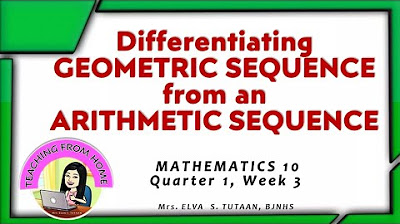GEOMETRIC SEQUENCE || GRADE 10 MATHEMATICS Q1
Summary
TLDRThis video introduces the concept of geometric sequences, exploring how a constant number is multiplied to obtain each subsequent term. It defines geometric sequences, identifies the common ratio, and demonstrates how to find the nth term. Through examples, the video explains how to determine whether a sequence is geometric and how to solve related problems. It also applies the concept to real-life scenarios, such as calculating the spread of infections in an outbreak. The video concludes with practice exercises to reinforce understanding.
Takeaways
- 🔢 A geometric sequence involves multiplying each term by a fixed number to get the next term, unlike arithmetic sequences where a number is added.
- 📈 The common ratio (r) in a geometric sequence is found by dividing any term by its preceding term.
- ✖️ To find the next term in a geometric sequence, multiply the last term by the common ratio.
- 🧮 The formula to find the nth term of a geometric sequence is a_n = a_1 * r^(n-1), where a_1 is the first term and r is the common ratio.
- 🔍 In the given examples, the sequences were analyzed to determine whether they were geometric by checking if the common ratio was consistent.
- ➗ A geometric sequence has a consistent common ratio across all terms, making it possible to predict future terms.
- ✅ The script provides a step-by-step guide to calculating the common ratio and identifying geometric sequences through various examples.
- 📊 The formula for the nth term is applied to real-life scenarios, such as calculating the spread of infections in a population.
- 🎯 The final example shows the application of the geometric sequence formula to predict the number of infections on the sixth day.
- 🔔 The video concludes by encouraging viewers to subscribe for more math tutorials.
Q & A
What is a geometric sequence?
-A geometric sequence is a sequence of numbers where each term after the first is found by multiplying the previous term by a fixed, non-zero number called the common ratio.
How do you determine if a sequence is geometric?
-A sequence is geometric if there exists a common ratio 'r' that can be determined by dividing any term in the sequence by the term that precedes it.
What is the common ratio in the sequence 2, 8, 32, 128?
-The common ratio in the sequence 2, 8, 32, 128 is 4, as each term is obtained by multiplying the previous term by 4.
How do you find the next term in a geometric sequence?
-To find the next term in a geometric sequence, multiply the last known term by the common ratio.
What is the formula for finding the nth term of a geometric sequence?
-The nth term of a geometric sequence is given by the formula a_n = a_1 * r^(n-1), where a_1 is the first term and r is the common ratio.
In the sequence 5, 20, 80, what is the common ratio?
-The common ratio for the sequence 5, 20, 80 is 4, as each term is 4 times the previous term.
Is the sequence √2, 5√2, 3√2 a geometric sequence?
-No, the sequence √2, 5√2, 3√2 is not a geometric sequence because the ratio between consecutive terms is not constant.
What is the tenth term of the geometric sequence with first term 8 and common ratio 1/2?
-The tenth term of the geometric sequence with a first term of 8 and a common ratio of 1/2 is 1/64, calculated using the formula a_n = a_1 * r^(n-1).
How many people will be infected with measles on the sixth day if the number of infections grows geometrically with a common ratio of 2, starting with 4 infections on the first day?
-On the sixth day, there will be 128 people infected with measles if the number of infections grows geometrically with a common ratio of 2, starting with 4 infections on the first day.
How can you find the missing term in a geometric sequence if you know the first term and the common ratio?
-To find the missing term in a geometric sequence, multiply the first term by the common ratio raised to the power of the position of the missing term minus one.
Outlines

Esta sección está disponible solo para usuarios con suscripción. Por favor, mejora tu plan para acceder a esta parte.
Mejorar ahoraMindmap

Esta sección está disponible solo para usuarios con suscripción. Por favor, mejora tu plan para acceder a esta parte.
Mejorar ahoraKeywords

Esta sección está disponible solo para usuarios con suscripción. Por favor, mejora tu plan para acceder a esta parte.
Mejorar ahoraHighlights

Esta sección está disponible solo para usuarios con suscripción. Por favor, mejora tu plan para acceder a esta parte.
Mejorar ahoraTranscripts

Esta sección está disponible solo para usuarios con suscripción. Por favor, mejora tu plan para acceder a esta parte.
Mejorar ahoraVer Más Videos Relacionados

MATH 10 : DIFFERENTIATING GEOMETRIC SEQUENCE FROM AN ARITHMETIC SEQUENCE (Taglish)

GCSE Maths - Types of Number Sequences - Arithmetic vs Geometric

Menemukan rumus jumlah Deret Geometri

Pola Bilangan [Part 1] - Mengenal Pola Bilangan

SEQUÊNCIAS NUMÉRICAS | QUER QUE DESENHE | MAPA MENTAL

Unit 1 Lesson 2 Practice Problems IM® Algebra 2TM authored by Illustrative Mathematics®
5.0 / 5 (0 votes)
